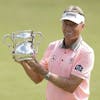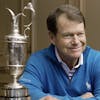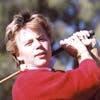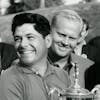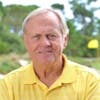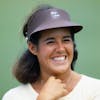Ben Crenshaw - Part 1 (The Early Years)
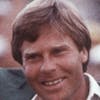
World Golf Hall of Fame member, Gentle Ben looks back on his youth, learning the game under the watchful eye of Harvey Penick, his second father, and being challenged by a young Tom Kite. Learn about the eerie history of Brookline in Ben’s life/career, where he discovered his love of the history and traditions of the Game at age 16. Ben and Bruce recount how their paths first crossed as the “Devil” gave an exhibition for the young men competing in the 1972 NCAA championship in FL. Share a magical moment as Bruce relates his story from the 1958 inaugural Eisenhower Trophy at St. Andrews where Bobby Jones gives an inspirational speech, one Ben has in his collection and is able to quote from memory. Hear about Ben’s remarkable amateur career and early tour successes as we talk architecture, technology and the most recent Masters. Ben Crenshaw provides an inspiring look back on his early life, “FORE the Good of the Game.”
Support the showFollow our show and/or leave a review/rating on:
Our Website https://www.forethegoodofthegame.com/reviews/new/
Apple Podcasts https://podcasts.apple.com/us/podcast/fore-the-good-of-the-game/id1562581853
Spotify Podcasts https://open.spotify.com/show/0XSuVGjwQg6bm78COkIhZO?si=b4c9d47ea8b24b2d
Google Podcasts https://podcasts.google.com/feed/aHR0cHM6Ly9mZWVkcy5idXp6c3Byb3V0LmNvbS8xNzM3Mjc1LnJzcw
About
"FORE the Good of the Game” is a golf podcast featuring interviews with World Golf Hall of Fame members, winners of major championships and other people of influence in and around the game of golf. Highlighting the positive aspects of the game, we aim to create and provide an engaging and timeless repository of content that listeners can enjoy now and forever. Co-hosted by PGA Tour star Bruce Devlin, our podcast focuses on telling their life stories, in their voices. Join Bruce and Mike Gonzalez “FORE the Good of the Game.”
Thanks so much for listening!
Intro music
Mike Gonzalez:Welcome to another edition of "FORE the Good of the Game" and Bruce Devlin, I'm really excited about our guest this morning.
Bruce Devlin:I'm not going to tell you who it is. I'll just give you an idea who it is. He was a 19-time winner on the PGA Tour. A dual Masters champion, three NCAA titles when he played in college. He's in the architectural business. He's got a wife and three daughters, which keep him busy. And we're just so proud to have Ben Crenshaw with us this morning. Welcome, Ben.
Ben Crenshaw:Thank you, Bruce. My old buddy. We've played a lot of practice rounds. A lot of tournaments together. It's a pleasure to be with you and Mike. You know, it's we've had a, I've had a, I've had a very nice career and the people that Bruce you and I've met and played with means a lot to me at this point in life, and I feel very lucky and fortunate to have gone so always nice to reminisce with old pals.
Bruce Devlin:Well, thank you, Ben, we were looking forward to chatting about all your wonderful career this morning. And, Mike, you know, we've had some nice guests, but but this one's pretty special.
Mike Gonzalez:Yeah, he sure is. And we've got so much to talk about. Ben, I think it might be good just to try to reminisce you two, in terms of when did you first encounter each other? What's your recollection of that Ben?
Ben Crenshaw:Wow, you know, I had the I was lucky, I got invited as an amateur to the Champions, Houston Champions tournament at Jackie Burke's club. And I played in the Colonial tournament three times as an amateur. And we met, you know, on the tournament trail in Texas, I'm sure. And I I had two, I was invited twice to Augusta. And I can't tell you how many practice rounds that I played with Bruce and David Graham. I just remember those days so vividly. had so much fun playing with them. And they, let's just face it, they were very nice to me I enjoyed their company. And I really got to see golf at a top level. And I was listening all the time. I just enjoyed their company. And they were very nice to have me along.
Bruce Devlin:I'm going to I'm going to prod your memory and a little bit Benjamin in 1972, the NCAA's were played in Florida at a place called Cape Coral. And there was a PGA Professional who went there and did a clinic for all of you guys, you remember who it was.
Ben Crenshaw:It had to be the"Devil."
Bruce Devlin:It was the "Devil" that was that was that was great meeting you and Tom and all the boys from the University of Texas and obviously all the other guys that you played against as an amateur. I'll tell you what, it was a great crew. If you look across all of the universities, aside from Crenshaw and Kite being the standouts of Texas, there are a lot of other good players there, too.
Ben Crenshaw:Oh, you bet. You know, I had the benefit. When I started traveling, as an amateur I started meeting and playing against people that I would play with the rest of my career. And you're so right, Bruce, you know, during that NCAA, there had some fabulous players. I'll tell you one player that always stood out to me. Could have been one of the best ball strikers I saw at that age was a guy named Eddie Pierce. He was from Tampa, Florida. And he went to Wake Forest, but I met Eddie when I was 16 years old in Boston. When he won the US Junior at Brookline, and I'm telling you what this guy could play like you can't believe God he was good. And his buddy Gary Koch, and who was a fabulous player Bill Kratzert are all kinds of people that we will later play with but you know, one thing sticks out in my memory when we started playing together, Bruce, and then David Graham pointed it out to me. We would watch you. And David would look at me said, Look, Look at his eyes. And so what do you mean? Just Just look, just watch his eyes. When he's when he's when he's swinging, and especially on the downswing and your eyes were fixed, past the ball, not on the ball, but past the ball. And I looked again, and I said, Wow, I just saw that. And, and I looked at David, and I said, What's he trying to do? He said, He's trying to pass that club head over that spot through the ball. I've never seen anybody do that. But boy, could you do it and you hit the ball so solidly. I said, Wow, that's, that's pretty interesting. But David pointed that out to me early on.
Bruce Devlin:Well, I don't know how it all started. But that was, that was something that a lot of people used to say about me, you know, why the hell don't you look at the ball instead of looking in front of it.
Ben Crenshaw:You know, that reminds that reminds me of a, of a Bobby Jones quote, you know, and I, you know, I'm like a lot of other people, I hold him in such high esteem. And I was fascinated how he wrote about the game. He was such a, he had such command of the English language and brilliant writer. And someone asked Jones, he said, Mr. Jones, do you look at the ball? Do you stare a hole in it? And he said, No, I don't, he said I'm merely conscious of its location. Which was an interesting way. I'd never heard that before.
Bruce Devlin:Well, I'm gonna move isn't until you shifted.
Ben Crenshaw:No. You're right. It's a stationary object, and we're trying to make it behave and man and sometimes we don't.
Bruce Devlin:How true that is.
Mike Gonzalez:So Bruce, you are recollecting your what you remember to be your first encounter with Ben Crenshaw back in 1972. Let's go back 20 years, Ben to growing up in, in Austin, Texas. Tell us a little bit about what that was like.
Ben Crenshaw:Wow, I had, I could not have had a better upbringing. My father was a good player, a lawyer, and had a bunch of good golfing friends. And my brother and I started I started when I was seven years old. My brother was 15 months older. We were members of the Austin Country Club under Harvey Penick. And, well, I had a bunch of good little players around me. And it you know, there's no substitute for competition. And, gosh, when I was when I was when Tom Kite was 11 or 12 years old, he came to Austin and started playing with us. And his father was a good player. And he was the Internal Revenue Service Director there in Austin. But I could tell from the moment I met Tom, and that was a, an adversary. A wonderful guy said, My gosh, you know, if I could play with him and and beat him every once in a while, I couldn't have had better competition, but there were 10 other kids who could play so in my mind, I was watching good golf. And it just helped. And Harvey was one of those people who sort of kept his eye on everyone. Harvey was a dear, dear man who helped us all and a consummate professional. Very, very, very few words. But they stuck. very much a fundamentalist.
Mike Gonzalez:So Ben, it sounds like you're a lot like Bruce and I, in terms of how you picked up the game, we all picked it up, really and got introduced to it from our fathers.
Ben Crenshaw:Well, I mean, we I, you know, you couldn't have better guidance, obviously, with your parents and if they play golf. You know, you. I know. In Bruce's case, I'm sure that, you know, sometimes there's an overbearing parent that maybe stifles the growth of youth but I had the best dad he was a little tough on me, but he was not overbearing. And I see that so many times. But apart from my father Harvey was like a second father to me. I owe almost everything I ever did in golf to that man. And we had him for a long time, a long time. And he was so, so fundamental, so direct and easily understood. Although he could get very technical with someone like Tom kite who was way more technical than I was. Tom was a practicer. I practiced a little bit, but I'd rather play. But Harvey knew that and sort of kept our teaching separate at an early age. So we've benefited from that. He knew he wanted to know what kind of person you were. Then he went, he went very much on that. But wow, to have the end of his life, at Augusta that week, I still can't believe it. I mean, I played beautifully that week. But when it was happening on Harvey's death, you know, Tom Kite now we're pallbearers that week. And we came back to Austin and buried him I went back over to Augusta. And I just played beautiful I never played a tournament with five bogeys. And very unlike me, I was up and down quite a bit. But to have won on that occasion will always bring a smile to my face the rest of my life. And I really I'm convinced. I'm convinced beyond any doubt that the Lord was honoring Harvey through me. That's the only way I can explain it,
Bruce Devlin:He was probably watching you too.
Ben Crenshaw:Yeah. Yeah, he was.
Mike Gonzalez:You know,looking, looking back on it, reading about it, watching the videos, particularly last day, seeing some of the fortunate breaks that you got. There was a higher power at work it seemed that week. So tell me that you must have had a wonderful high school team with you and Tom Kite playing for your Austin high school team.
Ben Crenshaw:Well we did Austin high was a was a very good team. We won the state twice. And Tom Kite's team Austin McCallum, good bunch of players too. So we always had things to make us keen. And when I started playing the state junior at Brackenridge Park at San Antonio. Man, you know, there were 600 entries. And you could see all these kids from around the state. God that was a particular favorite tournament of mine, old Brackenridge Park was such a fun place to play. But you'd see all these guys play and you can see how you stacked up. God it was fun with so much fun.
Mike Gonzalez:So take us through the college decision because you must have had a few schools coming after you and I don't know if you were close enough with Tom to where you sort of commiserated and strategized on whether you might attend the same school together. Talk us through that.
Ben Crenshaw:Well, I did. I was recruited mainly through University of Houston, and SMU up in Dallas. And I had a girlfriend at the time. Nancy Hagar, who was a wonderful player. She made the Curtis Cup team and her parents were the pros at Northwood Club there in Dallas, where they had the 1952 National Open where Julius Boris won, but I played a lot of golf there. I like Dallas. But my ties were too strong here in Austin. Besides Tom Kite, we had a good team building so George Hannon was our coach. And we wow we had a wonderful time. I played three years, played a lot of tournaments for the University of Texas and wow to have won the team championship twice was just fantastic. Gosh, we you know, I always say that I had the benefit of watching the Texas Longhorn football team, because they were winning national championships during the time and it sort of rubbed off on us and we were you know, we thought we were good enough to compete. And we had a great example right in front of us. So that helped.
Mike Gonzalez:Well, you're being modest not mentioning your three individual NCAA wins one of those a tie with Tom Kite. I think in 72.
Ben Crenshaw:Yes. I remember when I was a freshman, we played at Tucson National in 1971. And I was just back from playing in the U.S. Open at Merion. And lo and behold, I was paired with Bruce Devlin. And I think it was the first two rounds we played. If I'm not mistaken, Good Lord, I the first time I saw Merion and I loved it. Oh, what a What a beautiful golf course. And the conditions, you know, from that week going out to Tucson National were entirely different. But you know, a few of us had played in that national open there. But, you know, we were just gaining experience all the time, and I was just having fun playing. But our team won, we made a great comeback that last day in Tucson, and we overhauled Florida. The Gators we somehow beat the Gators that day. But we had a great time. Then it was the following year in 1972 were Bruce gave the clinic there. And Bruce, they tell me that course is no longer there. Cape Coral, which is sad. But we somehow came out on top there
Bruce Devlin:Met a lot of really bright young players back then, you know, obviously, led by both Ben and Tom, but golf courses come and go. I guess, Ben and you know a little bit about that, too.
Ben Crenshaw:Yeah, I do. We've had a couple of casualties. Bruce, you know, sad to see for one reason or another. But you know, you and Jack Nicklaus and Arnold Palmer, shifted your careers, your playing careers and and you know, you having grown up in Australia, some of the favorite courses of mine are in Australia. Wow, I count my lucky blessings that I've gotten to play Royal Melbourne, Kingston Heath, Commonwealth, all the courses. I just, I just absolutely fell in love with with architecture. And I did at an early age, I was 16 when I went to Boston, and playing The Country Club in Brookline, that was a totally different golf course. I was fascinated. And that's really where I got my love of golf architecture and golf history. And man my head has been in a book ever since I can't get enough. I wanted to know who who built the golf course, what their other accomplishments were. And I felt very, I felt very privileged that I was playing a place like Merion. I just fell in love with all of it.
Bruce Devlin:So Ben aftr seeing, playing and reading about all these golf courses. Give me a little bit of an idea of your actual philosophy, regarding building golf courses on different pieces of property. How do you how do you start?
Ben Crenshaw:Well, Bruce, I, at least my I had the great fortune of having a most wonderful partner in Bill Coore. You know, I'm pretty lucky 1985 was an unbelievable year for me because I married Julie that year and I struck up a partnership with Bill Coore. So it was a great year for me. But Bruce, what we do is find a suitable piece of land, number one. We don't particularly enjoy moving a lot of dirt. Although you and I know that there's so many people in the business who can move full scale pieces of Earth and do it really well. We're just not. We don't like to do that that much. We've been lucky about the pieces of property that we've worked with and we'd rather let the land speak for itself and make the holes fit the land. I always thought that that was an interesting study when you go to when you go to Great Britain and see some of the Scottish and Irish courses. They found a particular piece of land and they let the holes fit that And that was really a wonderful study in Australia. Australia has some of the best land I've seen for golf courses, you know, blessed with beautiful sand, handsome bunkers. And a mildly rolling property. But no, I have from what I enjoyed reading, and I thought that was the best way to do it. So we start with a good piece of land. And we, I've always said that the easiest thing in the world is to build a hard golf course. I think that it can be imbalanced and you want everybody to enjoy the game. You have to think about other people who play you know, it's one thing to have a tournament golf course, you can make that very tough. But there's, there's a way for elasticity, as well, some of the great courses in the world. I think anybody can can play them. And you know, we I guess you got to go back to the original. The Old Course at St. Andrews is the most fascinating course to me. Still, I mean, everyone who can hold a club can play that course. And it's just there's you, I suppose you could play it for half your life and still learn things about it every day. It's just endlessly intriguing.
Bruce Devlin:It's one of the one of the only golf courses that I've ever played where, on your way out, you play into the wind, and then the tide changes when you hole your putt at nine, and then you play back into the damn wind again, on the way in so one day it can play 6,500 yards and the next day it can play, you know, 7,000 yards, the wind has such a bearing on that golf course.
Ben Crenshaw:It really does. And it really makes you you know, as you're playing, you go well, I can't I can't remember that over there. And I said, you know, the other day I played past that and you know, now you're 50 yards short of it, you'd have to possess a great amount of knowledge on that course. And it's obstacles to get around and it's it's still it hasn't been tampered with that much. It's just it's a thing unto itself. Really
Bruce Devlin:A few extra T's, but not much, Ben, I know you played in the eyes and our couple you guys were able to be victorious at it when when I first went to the Old Course at St. Andrews was for the inaugural Eisenhower Cup matches. And on the second day we played there, the 11th hole, the little par three, right? What is it about 165, 170 I'm talking about back then it's a lot longer now. But I remember, not one soul in the entire field could reach the green with a driver. That wind was coming out of the cross from the airbase there from the north and must have been blowing 55 miles an hour There was a R&A member who was standing on the left front of the green. And when when because everybody had the chip when you chipped he'd chase the ball. And as soon as it stopped, he'd put a coin behind it for you. Well, that, you know, that went on for about oh, I don't know about an hour. And then then they decided that this really wasn't golf. So they they called it off for the day. So I thought that was very, very interesting that
Ben Crenshaw:Oh my God, that's amazing.
Mike Gonzalez:Ben just for history purposes. That was 1958 the inaugural Eisenhower and Bruce, why don't you remind us of who the winning team was that year?
Bruce Devlin:Yeah, well, the Americans finish second to a little upstart team from down in Australia. Which was a lot of fun. And then fortunately for me, I got a chance to come back. Back in 1960, when when we played it, Merion that was when that was when Nicholas broke Hogan scoring record around Merion which, which was quite unbelievable the score he shot I you know, I still still amazing today.
Mike Gonzalez:And the event 1958 Bruce, as I recall, you had an opportunity to meet Bobby Jones. At the Old Course
Bruce Devlin:I had the most remarkable evening that I've ever spent in my life. That that particular evening on the Thursday night. The city of St. Andrews gave Bobby Jones the keys to the city. And of course in those days, he was in his wheelchair. So they wheeled him into the auditorium. They had it in the town hall. And when he got up to make his speech he actually pulled himself out of the chair to an upright position in front of the microphone and just gave him the most wonderful speech that you Yeah, I don't think there was a dry in the house it was quite remarkable. And, you know, when you think of think of what he did as a player, as Ben said, He not only was a great player, but he was a, you know, a great orator and a serious thinker. It was a terrific night.
Ben Crenshaw:I have I have a copy of that speech. And I'm just so heartened to know that you were there. It was quite an occasion, as Bruce said, I've read about it. But to know that you were there, I know that you felt the full gravity of, of, of how he made that speech. And as an extemporaneous speech, it had to be one of the best of all time,
Bruce Devlin:I think so
Ben Crenshaw:He talked and talked about, talked about friendship amongst the nations, but personal friendships and what what the word meant to him. And I remember talking to the great sports writer, Herbert Warren Wind who was there. And he said, after he spoke, he's no, he said, Nobody could talk for 10 minutes. It was so powerful.
Bruce Devlin:It was quite quite an occasion Ben.
Mike Gonzalez:Ben I was on a walk this morning with my wife and our dog. And I ran into a friend and mentioned that we'd be speaking this morning. And one question they thought they'd like to know from you, relative to your interest in golf history is do you remember the moment that really kind of sunk in you said, Yeah, I really want to learn more. You mentioned a little bit about your trip to Brookline. Is that when it started, or do you really recall?
Ben Crenshaw:It certainly did. In Brookline, my father and I went up there it was 1968 USGA Jr. And we, you know, is a trip that I've never been to Boston, and we took the whole town in, we went to Fenway Park to watch the baseball. Now, we we went on the Freedom Trail in downtown Boston. And then to I had started to read a little history before that, and I found that this was the place where Francis Ouimet won in 1913. A 20 year old amateur from across the street from the Country Club, beat the two best British players at the time, Harry Vardon, and Ted Ray, in 1913, and an unlikely victory, but as I recall that it was one of the first times that golf was mentioned on the front page of any paper in the nation. It had such an effect. But the way that he won Francis and coming from across the street and caddied at the course it was just a, an idyllic sort of story. And lo and behold, he Francis made a putt on the 17th green there. Of course, that was the 71st hole of the tournament. And then they got in the playoff and then he made another putt on that green number 17. And his house was right across the street from the property and the whole story is captivating, so I kept that. I knew the Francis Ouimet story forever. And lo and behold later on I became named as Captain of the Ryder Cup at Brookline. And probably the most improbable putt that I have ever seen go down was Justin Leonard's putt on the 17th green. Now there's something very spooky about that. It was absolutely spooky. And we are we were rightly so rightly called out for, but it was kind of unsportsmanlike. It really was We shouldn't have done. We shouldn't have celebrated that. But nobody in the world would have expected Justin Leonard to make that putt. But wasn't that spooky that that's Francis' green. So from then on I called Justin Francis. He always gives me that funny look. And I said you did it. It was it was surreal. Just surreal. I was. I was kneeling on the back of that green with Dave Anderson from the New York Times. We kneeled together and Justin made that putt. And I looked at Dave and I said, That's Francis. And he just started laughing. It was just amazing. What a week what a week that was.
Mike Gonzalez:What a week is right. Let's take you back just briefly to your your amateur career. Is there anything you didn't win as an amateur?
Ben Crenshaw:Oh, yeah, I did not win the U.S. Amateur that I wanted to. I finished second to Vinnie Giles, the great old amateur from Richmond, Virginia. We played at Charlotte Country Club in Charlotte, North Carolina and I was second to him. But I did not win the U.S. Amateur I would have loved to but I didn't do it. No, I I was having so much fun. I played in the Southern Amateur and the Western Amateur. The TransMississippi, I was getting some great competition. And playing against some wonderful players. I was just having a ball.
Mike Gonzalez:I won't recount for our listeners, all the amateur wins. But you mentioned several of them and the list just goes on and on and on. You want a whole lot of tournaments. Back in that early 70's stretch. I wanted to ask you about the Walker Cup. Did the timing just not work out?
Ben Crenshaw:Wow, ironically, ironically, I would have made the team lo and behold at the at the Country Club in Brookline, that was the 1973 team. And I had a really tough decision because that was a place that I'd had a lot of affinity for, and I'd played there before. But we had a decision to make whether you wanted to turn professional or stay an amateur and play in that Walker Cup, it would have cost me one more year. So I've decided for better or worse to turn professional. So I started in that fall of 1973 and had to go to the qualifying school and then tried to make my way.
Mike Gonzalez:I think it worked out because you won your first tournament didn't you?
Ben Crenshaw:Well, I was in San Antonio, at the Texas Open and I remember I had to battle George Archer and Mike Hill and Orville Moody. They were trying to chase me down. And somehow I made a couple of putts and I got ahead of them stayed ahead of them. But that was quite a beginning. And you know, God, everybody said, well, you just I guess you're just going to win a whole bunch of 'em. I said, Wait a minute, I had an exceptional week and let's let's just let's try to start and gain a little knowledge and little proficiency and keep going but I had a very up and down very up and down career I had a my I was hardly consistent. I'd play well for a while. And then I'd fall back and start experimenting or you're doing something and it very much like this. It was I was never even keeled, let's say. So. But that's what golf is. its ups and downs. Isn't it Bruce?
Bruce Devlin:Yeah, I was just gonna say I don't think I know. Very, very few players that ever played golf for a living can say that they were consistently good all the time. I mean, even the great Jack Nicklaus, you know, we've he certainly probably until Tiger came along was the was the guy that we thought was the best player that ever lived. But you know, he had these moments as well. So.
Ben Crenshaw:He did you know, you Bruce, you remember you, Jack Nicklaus came back and won at Baltusrol in 1980. And he had a dry spell before that, you know, Phil Rogers have helped him on his short game. He worked very hard to get back up in there and then he played brilliantly at Baltusrol and Isao Aoki almost chased him down there, but that was a great comeback of sorts.
Bruce Devlin:Yeah, I agree with you.
Mike Gonzalez:So Ben went when you had a sort of a trough in your game? What was typically going on? Was it mental? Was it physical? Was it experimentation? What was it
Ben Crenshaw:I, I really enjoyed talking to other players generally? about golf and about the golf swing. And I would get sidelined on a different thought and I was trying to do this or do that. And, you know, I kept coming back to Austin and Harvey would would look at me. I remember one time he got pretty upset with me. He said, I said, Harvey, I'm kind of lost. He said, Well, let's go, I'll say I want to see a few. So I hit about 10 balls. And Harvey didn't say one word. And then he looked at me, and he put his arm on my shoulder. And he said, Ben, don't wait this long to come back and see me. And wow. And patiently. You know, he, he would say something like, swing like Ben, swing like Ben. And I tell you what, when you're filled with thoughts, and little habits, it's tough to find your way back to that. I suppose, Bruce, that, you know, all of us are built differently, our physical characteristics are different. But we all have one swing. And and we know what that swing is, we know what it feels like. But sometimes your thoughts get you to a point where you stray from that, and you try to do something that somebody else is doing. And then finally, you say, Look, I'm just incapable of that. So I was born with a swing, and I have to find it again. And it happened many times in my career. So I did play my best golf when I had almost no thoughts up here. You played by instinct, and you felt like your ball position was good, and your fundamentals were good. You had your own rhythm. And gradually, you find your way back again to play good golf. But boy, it's a tough game. It's a really tough game.
Bruce Devlin:Ben, you mentioned something right then about ball position. I've always, I've always been a great believer in it's a combination between ball position and alignment. Because you may have one, right, and the other one may be a little bit off, and it won't go where, you're thinking it's going to go. So that to me is always been the key, you know, when I see good players that get a little bit off, they do it very, very gradually either move the ball too far forward, or they get themselves too open to the target. Most people probably get too closed to the target. But I think ball position and alignment together is the most one of the most important parts of a golf swing.
Ben Crenshaw:And, Bruce, I don't think that you could have said that better because the two go hand in hand ball position dictates alignment, and, you know, and it disrupts your timing, you know, your your focal point, you know, sometimes you get over the ball and you say, well, that ball looks good to me in my stance. And I always found that if I put it too far back, I was a little bit to the right. And then if I was my ball was too far up in my stance, I'd be a little bit left so but I know I played my best golf when I didn't, I sort of fell into that stance. And it helped my backswing and I felt like the first two feet of my backswing was smoother, then it was something that you didn't have to search for. So, but it's difficult. I remember David Graham, I'll never forget this. David Graham told me. He said, you know, when I hit the ball the best at certain times, I would sort of make a paper graph and to have his feet and his ball depicted on that. And he said that was sort of a static look at how I was playing really well at that time. And that made that made a lot of sense.
Mike Gonzalez:So Ben, coming off the collegiate and amateur career that you had, why don't you describe for our listeners the sort of mental outlook level of confidence that you brought onto the tour as young man and maybe compare and contrast that to the, the younger guys coming on the scene today.
Ben Crenshaw:Well, I mean, I was a good player and I had the benefit of playing probably a dozen professional events. When I was an amateur, I was playing well at the time, and I was capable and played some good tournaments. But you know, part of, of getting on the Tour is learning how to travel, you know, where you go, where do you eat, you know, who you hang out with so many different things. It's no different than what they do now. But I can tell you, from what I see, these days, there are more really fine, capable young players that can really play golf, but maybe probably better than I thought of. I'm astounded at their abilities. Apart from hitting the ball a long way. I'm talking about different departments of the game, and learning how to score when you're not playing well, which is a lot of it. And learning to adapt. Learning courses. All of it is very, very interesting to watch. I, you know, one young player that came to my mind, you know, a few weeks ago was this young Will Zalatoris. And man, what a what a brilliant young player. I mean, he hasn't had a whole lot of experience, and he played really well at Augusta. But players like him, I just see so many good ones. God, they're, they're incredible how they can play at a young age. I'm not saying it's like tennis, the tennis, you know, people excel at a really young age, and then they're done when they're 30 years old. But the level of competition around the world is really keen. And I must say that Hideki Matsuyama. His performance at Augusta is is really something to, to take note of he was carrying the whole weight of the country of Japan on his shoulders, played some of the most beautiful little shots that I've ever seen. And I think Bruce will agree with me that that was one huge department of the game that that won for him in the scoring, and he hits the ball beautifully had that run, which was astounding after that delay. But man, he kept hitting those little pitches, all sorts of pitches, and bunker shots, saved a lot of shots. So, Bruce, and I know how, how important the short game is, you know, if the short game doesn't happen, your scoring is not going to happen. So I'm amazed at some of the level of proficiency these guys have these days.
Bruce Devlin:Well, and Augusta National is a perfect example of a golf course if you're a little bit off you better have a short game, man. If you you know, we've always said some guys can get it up and down out of out of a wastebasket. But I'm telling you, you need a lot of talent around you think of think of some of the little chips that he hit during that Masters win this year. They were just absolutely superb. I think you nailed it. You know he drove the ball good. But boy did he have his short game going.
Ben Crenshaw:Bruce, I don't know about you. But you know all the times that you and I have played there. You know, you can hit all the little shots around and practice all you want to around the greens and somehow when you miss the green you get over the ball and you go golly I haven't had this one before. I've got I've got you have to execute and imagination. And that's what makes it fascinating.
Mike Gonzalez:Thank you for listening to another episode of"FORE the Good of the Game." And please, wherever you listen to your podcast on Apple and Spotify, if you like what you hear, please subscribe, spread the word and tell your friends. Until we tee it up again, "FORE the Good of the Game", so long everybody.
Music playing:Outro music.

Crenshaw, Ben
Golf Professional and Golf Course Architect
For a man known for his love of golf history, Ben Crenshaw has been involved in quite a bit of it. From his beginnings with a Hall of Fame teacher to dominating the college level to emotional highs at the Masters and the 1999 Ryder Cup, Crenshaw has etched his name into some of golf’s most famous moments.
Crenshaw was introduced to the game by his father, Charlie, a schoolteacher. When Crenshaw was 8, his father placed him under the guidance of Harvey Penick, a teacher of such skill that he would eventually find his own locker at the World Golf Hall of Fame. Penick cut down a 7-iron for him, showed him a proper grip and watched as Crenshaw effortlessly whacked balls onto the green 75 yards away.
“Now let’s go to the green and putt the ball into the hole,” Penick told his new student. “If you wanted it in the hole, why didn’t you tell me the first time?” responded the first-time golfer, according to Penick’s best-selling Little Red Book.
“I’m going to leave y’all with one thought. I’m a big believer in fate. I have a good feeling about this.” (From Crenshaw’s press conference the day before the historic comeback by the U.S. in the 1999 Ryder Cup.)
Finding the hole was never a problem for Crenshaw, who was blessed with a putting stroke that would become his calling card. Charlie Crenshaw Sr. remembers when he bought his teenage son the Wilson 8802 blade putter that came to be known simply as “Little Ben.” “It was just a putter in Harvey Penick’s shop. Ben felt it and waggled it around for a while so I bought it for him. That club’s been the best…
Read More
New to FORE the Good of the Game?
Here are some great episodes to start with. Or, check out episodes by topic.














